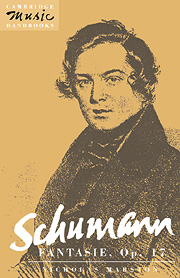Book contents
- Frontmatter
- Contents
- List of plates
- Preface
- Acknowledgements
- List of abbreviations
- 1 The compositional history of the Fantasie
- 2 ‘What's in a name?’ Genre and title in the Fantasie
- 3 Allusion and quotation in the Fantasie
- 4 Form in the first movement
- 5 Schlegel's leiser Ton and thematic unity in the Fantasie
- 6 Form in the second and third movements
- 7 The subsequent history of the Fantasie
- Notes
- Bibliography
- Index
- Plate section
6 - Form in the second and third movements
Published online by Cambridge University Press: 26 January 2010
- Frontmatter
- Contents
- List of plates
- Preface
- Acknowledgements
- List of abbreviations
- 1 The compositional history of the Fantasie
- 2 ‘What's in a name?’ Genre and title in the Fantasie
- 3 Allusion and quotation in the Fantasie
- 4 Form in the first movement
- 5 Schlegel's leiser Ton and thematic unity in the Fantasie
- 6 Form in the second and third movements
- 7 The subsequent history of the Fantasie
- Notes
- Bibliography
- Index
- Plate section
Summary
The attention traditionally accorded the first movement of the Fantasie has resulted in the second and third movements being decidedly neglected. Chapter 5 has begun to redress the balance by considering aspects of the thematic process in these movements and the relationship of their thematic material to that of the first movement. The purpose of this chapter is to examine their formal structures, for each is in its own way as original and problematic as the first movement.
The second movement
This movement has been the least discussed of the three. Wasielewski regarded it basically as a rondo form; Dahms thought it a ‘marchlike rondo’ whose formal structure was plain to see (übersichtlich); for Chissell it is ‘a sonata-rondo, an easy solution to the problem of large-scale architecture’ even Linda Correll Roesner, whose analyses of the first and third movements of the Fantasie stress the originality of Schumann's approach to form, regards it as ‘relatively straightforward in structure’. The rondo analogy arises obviously enough from the unmistakable entries of the opening theme; the sonata-rondo qualification tries to account for the transposed ‘recapitulation’ of a substantial secondary passage. Indeed, it is precisely because a background paradigm seems so much more obvious and unequivocal here that the second movement has been so consistently ignored. But rondo is not the formal paradigm against which this movement plays, and closer examination reveals an unsuspected formal complexity.
In Figure 6.1 the movement is analysed in terms of a large ABA or da capo structure, March I–Trio–March II.
- Type
- Chapter
- Information
- Schumann: Fantasie, Op. 17 , pp. 76 - 84Publisher: Cambridge University PressPrint publication year: 1992



